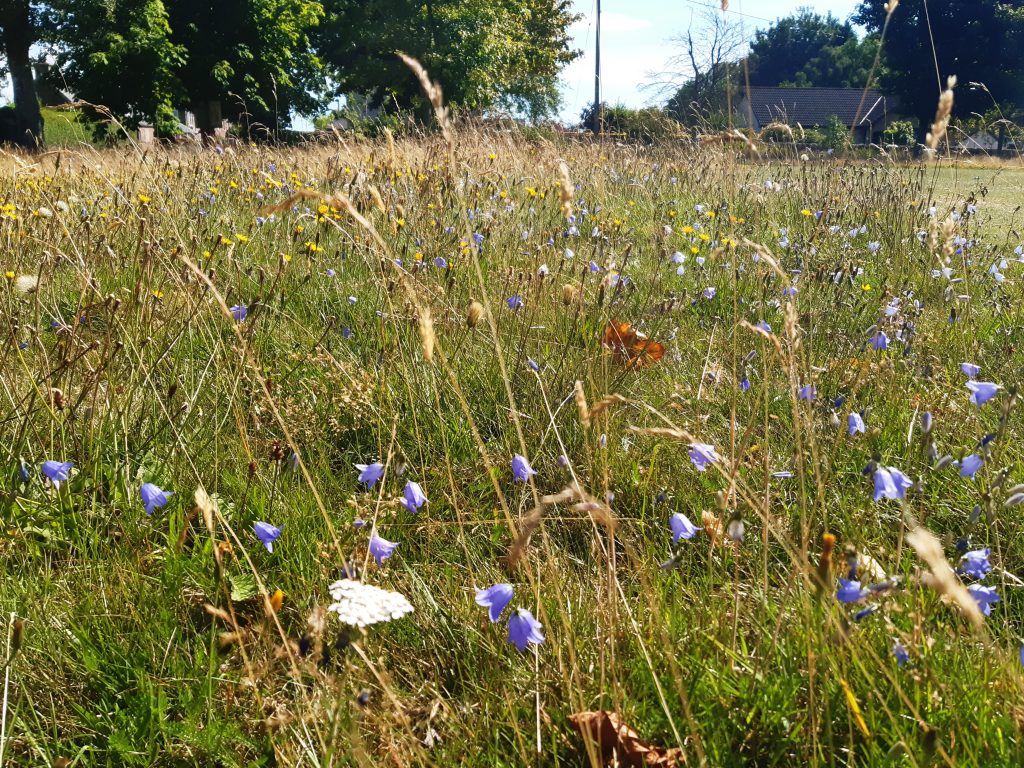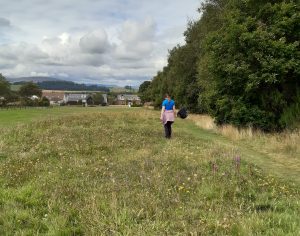
…blog by Claire Pumfrey, Buglife Conservation Officer,
There is no denying the fact that our wildlife and climate are in trouble, research papers and scientific studies continue to highlight significant levels of habitat loss and species decline. Pollinating insects such as bees, hoverflies and butterflies are essential to our ecosystems, they help us to produce nutritious food, and maintain a healthy environment. But, along with other insects, pollinator numbers have drastically declined due to the loss of wildflower-rich habitats. Those areas that do remain are small and fragmented. In the UK we have lost over 97% of wildflower-rich grasslands since the 1930’s!
But we can change this! Huge efforts are being made by numerous organisations to create and restore flower-rich habitats for pollinators. Buglife, through the B-Lines initiative, are working with partners to create habitat networks by connecting together our best remaining habitats.

The Strathmore B-Lines ‘People and Pollinators in Strathmore’ project focusses specifically on the Strathmore Valley. Through this project Buglife have been surveying a range of sites to understand if and how they are supporting a range of pollinating insects, and how these sites can be enhanced and conserved.
Fortunately a scatter of flower-rich grasslands remain, and remnants can be found along road verges and in areas of greenspace where fertilisers have not been applied and the flower seed bank still exists. This is evident at certain sites within the Strathmore valley including at Market Muir in Alyth and Kirriehill in Kirriemuir.
Up until recently on these sites the grass was cut on a fortnightly basis which is common for public green spaces. This prevents the flora from flowering and flourishing. A simple change was made by reducing cutting which has allowed the wildflowers to bloom, providing a burst of life and a much needed feast for a range of pollinating insects.

The most abundant plants recorded within the grassland at Market Muir were Sheep’s Fescue (Festuca ovina), Heath Bedstraw (Galium saxatile), Harebell (Campanula rotundifolia), and Common Cat’s-ear (Hypochaeris radicata). These plants are indicative of lowland dry acid grassland. This is a priority habitat and is characterised by vegetation dominated by grasses and herbs occurring on free-draining, base-poor mineral soils. Some of the other species recorded in this area, such as Sweet Vernal Grass (Anthoxanthum odoratum), Common Knapweed (Centaurea nigra), Lady’s Bedstraw (Galium verum) and Common Birds-foot trefoil (Lotus corniculatus) share characteristics with mesotrophic grasslands. Lowland Meadows are included as a priority habitat for Biodiversity Conservation under the Scottish Biodiversity List.
The floral diversity within the grassland at Kirriehill was also a welcome sight. This area was surveyed for pollinating insects as part of Sustainable Kirriemuir’s Bioblitz. Devils-bit scabious (Succisa pratensis), Common Cat’s-ear, Tormentil (Potentilla erecta) and Purple-Loosestrife (Lythrum salicaria) were some of the wildflowers recorded.
Pollinator species recorded included solitary bee species such as the Orange-legged Furrow Bee (Halictus rubicundus), Willughby’s Leafcutter Bee (Megachile willughbiella) and bumblebees including the Common Carder Bee (Bombus pascuorum) and its associated parasitic species the Field Cuckoo Bumblebee (Bombus campestris). The Marmalade Hoverfly (Episyrphus balteus), Common Dronefly (Eristalis tenax) and Yellow-barred Peat Hoverfly (Sericomyia silentis) were also amongst the pollinators taking advantage of the nectar and pollen provided by wildflowers within the grasslands.

All grassland types are valuable to invertebrates, providing areas for breeding, feeding, overwintering and hibernation. The Strathmore B-lines project which runs until March 2024 is continuing to survey grasslands and other flower-rich habitats along the Strathmore B-line, along with providing guidance and carrying out habitat creation and management.
Add your sightings to Strathmore B-Lines
An activity page for Strathmore B-Lines has been set up on iRecord and we’d love to hear about your sightings. We are particularly interested in records of pollinating insects and wildflowers. You can join the activity by:
🐝 Logging into your iRecord account;
🐝 Selecting activities and browse all activities;
🐝 Find Strathmore B-Lines in the dropdown menu and then select the star under Actions to ‘add to my activities’;
🐝 Then you’re all set to add your records to Strathmore B-Lines!
Even better is that the iRecord app has been updated to be more user friendly and will suggest species if you have photos!
To find out more about the Strathmore B-Lines Project get in touch with Buglife Scotland Conservation Officer Claire Pumfrey: [email protected]

